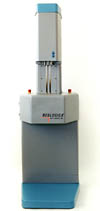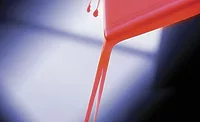Coating Rheology

Rheology is the branch of science dealing with the flow and deformation of materials. Rheological instrumentation and rheological measurements have become essential tools in the analytical laboratories for characterizing component materials and final products, monitoring process conditions, as well as predicting product performance and consumer acceptance.
Rheology Importance for Coatings
Rheological phenomenon is found in every coatings operation. Coatings, being complex structured fluids, need to be characterized by their structure and flow properties in order to be applied successfully. Rheology, which allows us to study the microscopic structure of colloidal systems by measuring their macroscopic flow behaviour under shear and extensional flows, is the ideal method of studying coatings. The study of flow behaviour of concentrated suspensions like coatings has always been of great interest in rheology due to their unique rheological characteristics and required rheological application performance.
The General Nature of Coatings
The applications of rheology vary from one class of materials to another because the mechanical behavior during processing can be quite different. Both the behavior of the material in process, and the method of processing are linked to the composition of the material, which in turn governs its final function as the product. Neither one could be altered independently since one determines the other. The change in rheological properties of a suspension is a manifestation of the type and magnitude of particle interactions of the sample. Therefore, a survey of the general composition and material characteristics of the product involved precede the determination of the rheological techniques used in the coatings industry.
The objectives of applying a coating fall into several categories: improved or changed appearance; enhanced durability and wear resistance; protection of inner structure; and improved processibility. To understand the coating process we have to gain insight to such things as surface properties, structure, joining interface, flow properties, as well as consideration of the actual process being used.
For polymeric materials and many other types of coating materials, one of the most powerful analysis tools is the RheoCapillary P9 Twin Bore Rheometer because it can simulate both the process conditions and give accurate information on the final product.
Coating Properties
For an application in which the coating process involves extrusion and molding, where the coating is applied in a molten state around a filament, film or an object (such as a bottle), we have to understand the material properties while under deformation and when finished. This is done by first heating the material in question in a chamber and then pushing the material through a die. The RheoCapillary P9 Twin Bore Rheometer uses two dies, one long and one short in order to do two experiments, which yield information of elongational properties and conventional shear properties. Both are required to describe even the simplest flow analysis. The apparatus is set up to push material through both dies at varying rates of delivery. The rates are chosen to find what happens during typical processing conditions.
The finished product properties, of such diverse things as surface finish and durability, can be determined from the visual examination of the test extrudate and by melt strength determinations on the extrudate, while it is being drawn from the die in the semi-molten state. Additionally, molecular weight and molecular weight distribution can be deduced from the shear viscosity, provided a sufficiently large shear rate can be deployed.
The test equipment can give advanced warning of poor or successful formulation by revealing, for instance, whether the surface finish is affected by inappropriate delivery rates in the production process. The materials may suffer from melt fracture, which is an extrusion instability and which can cause poor, uneven surfaces, such as shark skin, orange peel etc. Off-line testing can be used to avoid such problems by identifying the critical bands of process shear rates. In turn, formulation of the coating can be improved by this form of testing.
Coating Processes
The process and the end product are inevitably linked. Any coating process has to bring two or more streams of product into contact. Conventionally, this takes place in the melt just beyond the extruder screw section in a joining tract. The materials preparation in the extrusion process and the joining conditions are critical to a good coating. These elements can be readily understood through a rheological study.
Conclusion
This article has touched on a few points of the testing of coatings materials and the optimization of the coatings process. REOLOGICA Instruments/Porpoise are a leading provider of Twin Bore rheometers. The companies have their roots in automated rheological measurement for process optimization and quality improvement, both in-line and at-line. This capability has resulted in the manufacture of a range of fully calibrated, high-productivity instruments known simply as the P5 and P3. These leading-edge systems are now making their mark in the world markets.
For laboratory instrumentation we have the RheoCapillary P9. It shares many of the attributes of the process counterparts. Its reliability is complemented by user-friendly software, and ergonomics result in a very productive test platform.
The RheoCapillary P9 has many measurement accessories, such as melt strength, video die swell, along with data processing and analysis facilities, which include direct data linkage to the renowned Compuplast flow (CFD) packages. This approach ensures clear and concise understanding of extrusion and coating processes alike.
For further information, contact REOLOGICA Instruments at 609/758.1750 (east coast) or 818/753.2960 (west coast); e-mail info@reologicainstruments.com, or visit www.reologicainstruments.com.
Looking for a reprint of this article?
From high-res PDFs to custom plaques, order your copy today!




